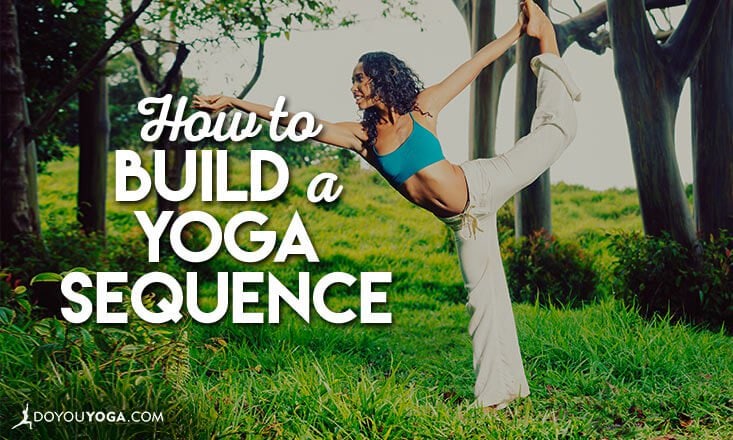For new yoga teachers and students wanting to build their home practice, creating a yoga sequence can seem daunting. From choosing poses, to remembering what you did on the first side in a sequence, there’s a lot going on in a yoga class.
The truth is that each yoga class follows a rough outline, and once you’re comfortable with that, filling in the blanks becomes second nature. If you’re looking for some more inspiration, you could take part in the free 30 Day Yoga Challenge. You’ll take part in a number of flows that might even influence how you put together your own!
While different styles of yoga will dictate just how the sequence goes, most classes will have similar elements. If you’re going for an all levels Hatha or Vinyasa class, keep the following things on how to build a yoga sequence in mind:
Theme
Every good yoga class follows a theme. This can be very specific like attracting abundance, or as simple as hip opening. Having this idea in mind helps to create a cohesive and inspiring class.
You’ll want to introduce this theme in the beginning of class, and continue to circle back to it, making it clear how the poses are connected to the larger theme. You can even read a quote, offer a meditation, or include an essential oil that caters to your theme.
Poses
What poses you choose to use in your sequence depends on your theme. If you’re working on hip opening, you’ll want to focus on poses that address the hips. If you’re thinking about abundance, you’ll incorporate heart opening poses that open the students’ hearts up to the universe.
No matter the theme, you’ll want to include poses from each category in your class: twists, standing poses, seated poses, supine/prone poses, backbends, inversions, and restorative poses.
You’ll also want to think about a peak pose for your class. This will be the most challenging pose or deepest stretch of the class. If you think about what you want this pose to be, it’s easier to pick which poses you incorporate earlier on. For example, if your peak pose is Half Moon, you’ll want to work on hip opening and balance.
Timing
Most studios classes are around an hour long. You can break down that hour into very manageable chunks to outline your class.
- The first 10 minutes typically start with a breathing exercise and some gentle floor stretching.
- The next 20 minutes will include either dynamic flow sequences (Vinyasa) or postures held for 3 to 6 breaths (Hatha). This usually includes Sun Salutations, Warriors, Triangle, Standing Twists, and other standing poses.
- For the next five minutes, you’ll work on a peak pose, one that you’ve been working up throughout the class.
- Another five minutes can be dedicated to standing balancing poses. This can be interchanged with the peak pose depending on which makes sense. If your peak pose is on the ground, work on balance first. If the peak pose is a Revolved Triangle or Bound Warrior, incorporate it at the end of the 20 minute chunk.
- The next 10 minutes should be spent winding things down. Move to the floor and work on seated and prone poses.
- The final ten minutes should be spent in Savasana and in seated mediation.
Flow
A good yoga class has a logical flow to it. You want the poses to weave together intuitively. It would be strange to go from seated poses straight to a Tree. Instead, think about working your way up from low to high poses. Maybe do Low Lunges before Warriors. Use Cat/Cow to transition from seated poses to Down Dog.
As you create a plan for your class, don’t forget to think about the transitions. Getting from one pose to the next is just as important as the poses themselves.
Safety
Beyond having a logical flow, you also want your students to be properly warmed up and prepared for each pose. You would never start a class with a Full Wheel without properly warming up the spine.
It is important for yoga teachers to understand anatomy and the human body to make sure that they keep their students safe. If you’re practicing at home, be very careful to listen to your body and see how it reacts to certain poses. If things feel off, think about what you could have done differently to protect yourself.
Counter Poses
As advanced yogis we sometimes forget how challenging the practice can be at first. We may be tempted to create long, challenging sequences for our students.
One easy way to be sure that you’re giving your students time and space to recover from each pose is to offer counter poses. If you have your students holding a Warrior II, they might be feeling it in that front quad. Offer a chance for relief by straightening the front leg for Triangle before going back for a Reverse Warrior.
Essentially, if the leg has been bent for a long time, think of a way to straighten it, and vice versa. This applies to seated and standing poses alike.
This may all seem overwhelming at first, but I promise it’s all very simple. If you’ve been practicing yoga for a long time, chances are your body already understands how to move through the poses intuitively. Most teachers even say that they rarely come to class with a set plan and just let the flow come to them based on what they see their students needs.
After all, being able to go with the flow is the trait of a well trained yoga teacher!
Did you find this helpful for building your own yoga sequence? Share your thoughts with us below!


